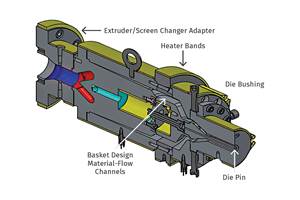Plastics a Carpenter Could Love
Jim Rock has tried to put sawdust into plastics off and on for 20 years, long before wood composites became fashionable.
Jim Rock has tried to put sawdust into plastics off and on for 20 years, long before wood composites became fashionable. After first working with Union Camp in the 1980s and Erwin Forest Products in the ’90s, Rock formed his own consulting firm in 2000. Called Southern Composite Technology, it has 14,000 sq ft of laboratories in Newport News, Va., for testing building-code compliance of all types of lumber—wood, plastic, and anything in between.
Wood/plastic composites still fascinated Rock, especially as he understood more of the shortcomings of some of the commercial products he tested. So he bought a used Cincinnati Milacron CM 80 HP conical twin-screw extruder and began experimenting with extruding polypropylene composite lumber of his own. The resulting boards, which will become commercial next month, are believed to have the highest levels of wood filler (a minimum of 60%) combined with the highest level of foaming (40% weight reduction) of any lumber product on the market.
His is one of the few composite lumber grades that can be worked, sanded, planed, and painted like real wood. It is even close to the weight of natural wood. Commercial boards will have a density of 0.75 g/cc, equivalent to natural ash. The unfoamed composite would have a density of 1.15 g/cc. Rock has produced densities down to 0.65 g/cc on a developmental basis but hesitates to commercialize them because that would require retooling and reformulating. “Every step down in density is harder to make,” he explains.
He struggled for three years to develop a production-worthy process to make the lumber. Eventually he bought a failed PVC fencing plant in Lowland, Tenn., which gave him the material-handling, drying, and downstream cooling equipment that he needed to get started. His first two production extruders, 114-mm and 140-mm parallel twin-screws from ExtrusionTek Milacron, will be delivered this fall.
Works like wood
Rock says the big distinction between Southern Composite’s boards and virtually all the rest is that a carpenter can cut and build with his lumber just like real wood, instead of having to orient the boards so that their aesthetic surface layer shows on the outside, like other plastic lumber. And unlike coextruded deck boards, he doesn’t have to cover up the unsightly cut ends where the cap layers show.
Southern Composite is not aiming for decking products. Instead it will make exterior trim, which is designed to accept paint and competes with wood, composition board, and PVC. Unlike PVC exterior trim, his boards can be painted in dark colors without fear of heat distortion in hot climates. His boards also pass PPG Industries’ proprietary paintability test.
Most foamed wood composites are based on polystyrene or PVC, which are amorphous and easier to foam because they hold bubbles better. Only a couple of other processors use crystalline PP—Correct Building Products in Biddeford, Me., and Mikron Industries in Kent, Wash. Both have been in production for about five years, but neither one makes a product with both the high foaming level and high wood content of Rock’s product.
He gives much of the credit for development of his patent-pending product to support from additive supplier Reedy International Corp. in Keyport, N.J. Reedy worked two and a half years with Rock to develop the foaming agent and lubricant package for such a high wood content. “I compare it to trying to blow bubble gum with a mouthful of oatmeal cookie,” Rock explains. “The wood filler doesn’t foam, and there’s not much plastic to hold the bubbles.”
For three years Rock has been Southern Composite’s only employee. But now he has two colleagues: a sales manager and a toolmaker. “That’s handy with a product that requires new tooling every time you make a density change,” Rock notes.
Related Content
This Tubing Processor Is Used to the 'Hard Stuff'
Kent Elastomer Products has emerged from its beginnings as a supplier of latex dip tubing to a leading manufacturer of high-end tight tolerance tubes for a range of applications.
Read MorePart 2 Medical Tubing: Use Simulation to Troubleshoot, Optimize Processing & Dies
Simulation can determine whether a die has regions of low shear rate and shear stress on the metal surface where the polymer would ultimately degrade, and can help processors design dies better suited for their projects.
Read MoreA Processor's Guide to Making World-Class Multilumen Tubing
Process innovation is pushing catheter design to the limit. Here are Lubrizol’s tricks of the trade.
Read MoreHow to Select the Right Tooling for Pipe Extrusion
In pipe extrusion, selecting or building a complementary set of tooling often poses challenges due to a range of qualitative factors. Here’s some guidance to help you out.
Read MoreRead Next
Beyond Prototypes: 8 Ways the Plastics Industry Is Using 3D Printing
Plastics processors are finding applications for 3D printing around the plant and across the supply chain. Here are 8 examples to look for at NPE2024.
Read MoreSee Recyclers Close the Loop on Trade Show Production Scrap at NPE2024
A collaboration between show organizer PLASTICS, recycler CPR and size reduction experts WEIMA and Conair recovered and recycled all production scrap at NPE2024.
Read MoreMaking the Circular Economy a Reality
Driven by brand owner demands and new worldwide legislation, the entire supply chain is working toward the shift to circularity, with some evidence the circular economy has already begun.
Read More











